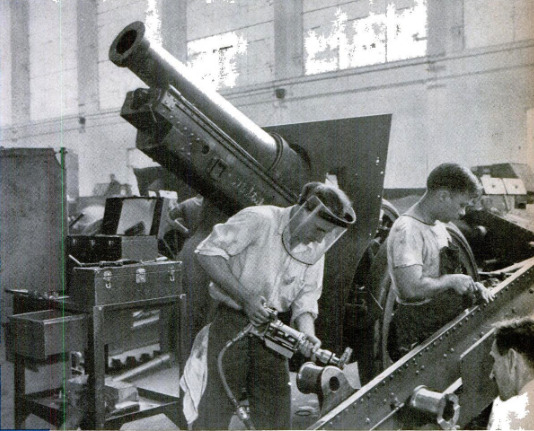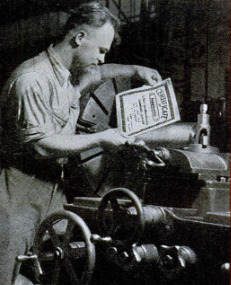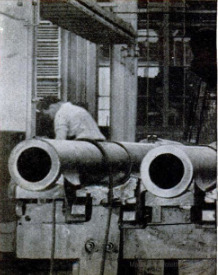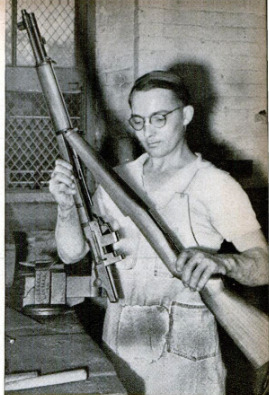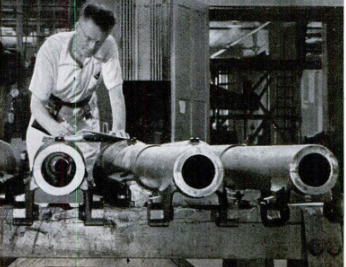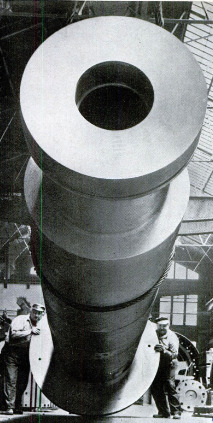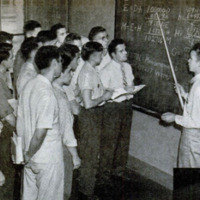-
Title (Dublin Core)
-
Industry goes to war
-
Article Title and/or Image Caption (Dublin Core)
-
Industry goes to war
-
extracted text (Extract Text)
-
AMERICAN industry is mobilizing its
men and machines to fill the big-
gest and most important order it
has ever received. Time-to-go-to-
work whistles that have been silent for
years are blowing again. New plants are
being built. Government arsenals are work-
ing three shifts, six days a week. By next
spring our manufacturing machine will
have been shifted into high to turn out the
airplanes, guns, fighting ships, and muni-
tions we must have to make us safe against
any form of aggression.
It took Hitlerized Germany seven years
of peacetime “total” mobilization to get
ready for the current war. Never in all
history had there been anything that
equaled that awe-inspiring national effort.
It was a peacetime mobilization that
missed no one. Industry was controlled
by the placing of “must” orders and
the allotment of raw materials, and
the salaries of its executives ‘were
limited by government regulation.
Labor, which worked seventy hours a
week, was controlled by the outlawing
of unions, prohibition against chang-
ing jobs without official approval, and
outright conscription. Capital was con-
trolled by compulsory investment of
profits in no-interest government se-
curities or in unprofitable enterprises.
It was strictly an “or else” program.
Orders were backed up with threats
of heavy fines, economic ruin or, for
the really obdurate, a concentration
camp or even a firing squad. Those
seven years cost the German people
their political and economic freedom
and the equivalent of 40,000,000,000
American dollars, but they gave the
Nazis the most nightmarish war-mak-
ing machine the world has ever seen.
In an effort to assure the safety of
the United States in a world which
gives every indication of remaining
rough, tough, and dangerous for a
good many years to come, Congress in
the course of its present session has
appropriated over $10,000,000,000 in
the form of cash and of contract authoriza=
tions, for national defense.
Those appropriations will be spent) to
order 14,394 airplanes for the Army /and
Navy, and so make a start on a program
which calls for the production of 25,000
planes a year by July 1942; to procure com=
plete armament and equipment for a/mod-
ern, highly mechanized army of 1,200,000
men, and the hard-to-get-in-a-hurry items of
armament and equipment for an additional
800,000 men; to start the building of ap-
proximately 200 additional fighting ships
which will give us a Navy powerful enough
to control the Atlantic and the Pagifie at|
the same time; and to provide new national-
defense construction and manufagturing
facilities, including the expansion of sHip-
yards and the building of thirty-one ord-
nance plants far enough away from our
Coasts to be beyond the range of air attack.
Congress has supplied the necessary
billions. Transforming those billions into
bombers and fighters, into antiaircraft
canon and field guns, into ships, tanks,
motor trucks, O. D. uniforms, Garand
rifies, undershirts, and the 70,000 or so
other things the fighting services need is
industry's big job.
Hitler, using the dictatorial “entweder
oder’ method of getting things done,
achieved astounding results by handing
Germany's industrial mobilization over
to the rotund, hard-boiled, and able Mar-
shal Hermann Goering and his economic
general staff of impressively uniformed
officials. Uncle Sam, sticking to our demo-
cratic “Let's go, gang!” method of volun-
tary cooperation, is confident of getting
equally satisfactory results by having the
production end of our preparedness pro-
gram guided by industrial experts who work
for the Government for nothing a year and
who think, act, and look very much like the
thousands of other doing-all-right Ameri-
cans you can see any week day on New
York's lower Broadway, Chicago’s LaSalle
Street, Detroit's Cadillac Square, or at the
Rotary Club luncheon in Springfield—
Massachusetts or Illinois.
To get those experts on the job, late in
May President Roosevelt used the powers
of the National Defense Act of 1916 to re-
vive the World War Advisory Commission
to the Council of National Defense, which
had been dormant for almost twenty years.
The Commission acts as a cobrdinating
agency between the Government depart-
ments which have to procure national-de-
fense material for the armed services and
the industries which will have to provide it.
‘When he made his appointments to the
key positions on the National Defense Ad-
visory Commission, President Roosevelt
gave the world a convincing demonstration
of the fact that the United States still is a
country where the really big jobs go to men
who have proved that they have what it
takes to handle them.
William S. Knudsen, automobile assembly-
line wizard left his big job as president
of General Motors to cobrdinate the produc-
tion of defense material, break bottle-
necks, and be the Commission's all-around
trouble-shooter. Edward S. Stettinius, Jr. re-
signed his $100,000-a-year position as chair-
man of the board of the U. S. Steel to become
the Commission's procurer of raw materials. Sid-
ney Hillman, who is in charge of codrdinating
labor and of training workers for the defense in-
dustries, has been president of the Amalgamated
Clothing Workers of America ever since the or-
ganization of that union in 1914.
The other members of the commission are
Ralph Budd, the president of the Chicago, Bur-
lington and Quincy Railroad, in charge of cobrdi-
nating all our transportation facilities; Chester
C. Davis, a member of the Federal Reserve Board,
who is responsible for accommodating agricul
tural problems to the defense program; Leon
Henderson, of the Securities and Exchange Com-
mission, in charge of the statistical study o
prices; and Miss Harriet Elliott, dean of women
at the University of North Carolina, whose
duties include the protection of consumers
And trying to keep down the cost of living.
None of the commissioners receive salaries,
but the Government pays their expenses. All
of them are assisted by staffs of executives
and expert advisers.
While the Commission has no formal exec-
utive authority, it reports directly to the
President and under the National Defense
Act he President has all the authority he
needs to drive through the defense pro-
grams authority to establish priorities
which would give Government orders the
right of way whether or not business men
liked it, and authority to place compulsory
orders. | So the Advisory Commission has
iron fists, although it has worn, and is likely
to continue to wear, velvet gloves over them
in its dealings with industry.
Its methods are well illustrated by its
Handing of the question of priorities. Sup-
pose, fOr example, that Greene & Browne,
who are in the toy business, decide to bring
out a new-design kiddie car, and place their
order fOr the machine tools necessary to
manufacture it. A week or two later Black
& White sign a contract to make—let’s say
— antitank-gun parts. They must have spe-
cially designed machine tools to make them,
and they can’t get those tools in a hurry
because Greene & Browne got their order
in first. Black & White go to the Advisory
Commission with their troubles. Antitank
guns being, in the present unhappy state of
world, affairs, considerably more essential
to the nation’s welfare than kiddie cars, the
comimission could ask the President to paste
a priority label on Black & White's order,
and Greene & Browne would have to wait
and Whistle for their tools. But the Com-
mission doesn’t do that. Instead, one of its
repres ntatives calls on Greene & Browne
and explains the situation. Greene and
Browne go into a huddle and, being patriotic
citizens, come out of it with an offer to hold
over their new kiddie car until next year so
that Black & White can get those antitank-
gun parts into production.
The Commission calls that the preference,
or voluntary priority, system of procure-
ment, and up to date it has worked so well
that there has been no need to enforce legal
priorities in order to get results.
The way in which Ralph
Budd, the Commission’s
transportation codrdinator,
deals with the railroads pro-
vides another example
of the “Let's go, gang!”
nethod of getting things
done without fuss or bad feel-
ing. Noticing that on June 1
there were almost 164,000
box and open-top cars—
slightly over ten percent of
the railroads’ freight-carrying
rolling stock—awaiting re-
pairs, and anticipating heavy
defense-industry traffic this fall, he wrote (as
one railroader to another) to the president of
the Associatione of American Railroads sug-
gesting that to, make Sure that they would
be able to do their part of the defense job
the lines should redftice the proportion of
“bad orders” to less than six percent by
October 1. The October figures aren't avail-
able yet, but it’s a dollars-to-doughnuts bet
that When they are released they will show
that the number of cars needing repairs
has been reduced below the requested figure.
ITS ability to make good use of the per-
sonal approach is one of the Advisory Com-
mission’s biggest assets. The automobile
manufacturer who gets a letter from it ask-
ing him to go into the making of airplane
cannon knows that it didn’t come from some
War Department brass hat, but from Big
Bill Knudsen, the fellow who knows all
about assembly lines. The union official
‘who is asked to solve the labor problems of
a shell-making plant knows that he isn't
dealing with some office-holding theorist
but with Sid Hillman, a veteran labor man.
Gaudy uniforms and high-sounding titles
may impress people in some countries, but
American business men like to do business
with men who wear the same sort of
clothes they do and who speak their lan-
guage. That's one of the reasons why, even
if some day we should get into a big war,
our industrial effort will be guided by
civilians.
One of the reasons for bringing Knudsen
to Washington was that he is a famous
breaker of production bottlenecks. The
first bottleneck he attempted to break on
his new job was in the machine-tool indus-
try. Machine tools are necessary for the
production of every weapon from a .30
caliber rifle to a sixteen-inch harbor-defense
gun. Shells can't be made without turning
lathes, and the armor plate for a battleship
can't be worked without huge planers and
millers. A serious shortage of machine tools
would block our defense campaign before it
ever got started.
The firms in the industry offered the
Government 100-percent cooperation, indi-
vidually and through the National Machine
Tool Builders Association. They already
had cracked one of their own potential
bottlenecks by starting to train workers
both in their plants and in codperation with
vocational schools. Priorities weren't neces-
sary. All that was needed was to tell the
tool makers what the Government wanted
first. They put their facilities as completely
at the nation’s service as if war had been
declared. They codperated with the Com-
mission's and the Army Ordnance Depart-
ment's experts in designing a machine
“Whe doubles the production of rifle bar-
rels, and in the development of a simple
single-purpose lathe which can, if neces-
sary, be operated by a woman and which
can be produced by others than expert ma-
chine-tool makers. The work of the tool-
making industry hasn't been spectacular,
and some of it of necessity has been slow,
but it has been highly effective.
Many people have feared that a shortage
of some critical raw material might seriously
handicap our rearmament. That is possible,
but the danger seems remote. We have
nearly all of the materials we need, and
have them in quantities which are prac-
tically inexhaustible. For some years Gov-
ernment agencies have been building up
stock ples of materials which we can't
produce and which we might have trouble
in getting in an emergency. Just how large
those stock piles have grown no one outside
the Government knows, but it Is no secret
that since Stettinius was appointed to the
National Defense Advisory Commission's
procurement Job he and his staff have dis-
played very considerable ingenuity in add-
ing to them.
Most of our rubber comes from the Malay
Peninsula and the East Indies, and our sup-
ply might be cut off if Japan went on the
warpath against us. That would have been
fatal twenty years ago, but it is much less
serious today. Several American manufac-
turers are ready to undertake the large-
scale production of synthetic rubber made
from petroleum.
Ordinary gasoline, the lifeblood of mech-
anized warfare, presents no problem. Our
supply of 100-octane gas, of Which our ex-
panded air forces will use tremendous quan-
titles, is being conserved by means of an
embargo, and adequate reserves are being
stored in safe places.
The chemical industry is coSperating
whole-heartedly in the national effort, even
to the extent of its members exchanging
closely guarded secret formulas with their
competitors!
EVERY bit as vital to our national defense
as the man with the gun are the men be-
hind the man with the gun. The number of
workers necessary to arm and equip each sol-
dier and keep him supplied with the food, am-
‘munition, clothing and all the other things
he needs in war have increased in propor-
tion with the increased mechanization of
warfare. In the World War we needed six
workers for every soldier. At the outbreak
of the present war German military authori-
ties estimated that they were going to need
eighteen workers for each soldier!
Rearmament is different from war be-
cause it doesn’t have to make good the in-
credible loss and waste of
war, 50 we won't need so
high a ratio of men in
overalls to men in uni-
forms. Industrialists figure
that during the coming
year our defense program
won't demand more than
a tenth of our industrial
productiveness.
After investigating our
probable manpower needs,
Sidney Hillman says that
the reservoir of our 5,500,-
000 unemployed workers
will take care of most of
our labor problems of the
near future. Many of
these men are unskilled,
but many others of them
were skilled, and the Gov-
ernment is’ giving them
the opportunity to take
refresher courses, at
W.P.A. wages, to bring
back the skill they lost
during their years of rust-
ing. Large numbers of
unemployed youths are
being trained for the de-
fense trades. The Gov-
ernment also is cobperat-
Ing with employers in |
providing on-the-job train-
ing for employed workers
Who want to qualify for
better jobs, and in train-
ing apprentices. The
United States Employ-
ment Service, which has
‘over 1,500 offices, wil help
in bringing the right
worker and the right job
together, and in overcom-
ing labor shortages in in-
dividual trades and in par-
ticular localities.
‘We have the money, we
have the materials, we
have the manufacturing
facilities, and we have the
men. What are we doing
with them? Are we get-
ting anywhere with or
rearmament job?
Perhaps our progress i
increasing our air force is
disappointing to optimists
who expected to‘see those
50,000 airplanes President
Roosevelt mentioned fly-
Ing before this winter. it
isn't disappointing to the
Then in the industry who
knew the tremendous amount of make-
ready work which would have to be
done to increase production from a few
hundred planes and engines a month
to 50,000 planes and 125000 engines a
year. Most of the planes on order now are
training planes—they are needed first.
Knudsen is confident that the industry, in
addition to filling its British contracts, will be
able to give us 18,000 Army and 7,000 Navy
planes by July 1942. It will take at least
another two years for it to reach the 50,000-
a-year production level.
Most of the 10,340 large and small manu-
facturing plants—located in forty-five states
—which have been approved by the Army
and Navy have received orders and are
working on them.
AMERICAN industry is literally beating
Plowshares into swords. Manufacturers |
of agricultural implements are producing gun
carriages and combat wagons; producers of
lathes for making wooden shooting-gallery
ducks are turning out lathes for army
shoes; church pipe-organ makers supply |
wooden frameworks for military saddles.
Makers of printing presses are producing |
the recoil mechanisms for 155-millimeter
howitzers; manufacturers of vacuum clean-
ers are making gas masks, and specialists
in adding machines are turning out shell
fuses. Factories that formerly created toy
soldiers and miniature trains are develop- |
ing gears and canteens; troops in the field |
will sleep under mosquito netting furnished
by firms that make ladies’ underwear.
Weapons are rolling off the production
lines in Government arsenals and privately
owned factories. The Springfield Arsenal is
making 1,560 Garand rifles a_ week; two
years ago its production was 150 a week.
One manufacturing plant is turning out an
average of six light tanks a day.
Work has been started on a Govern-
ment-owned, Du Pont-operated powder
plant at Charlestown, Ind. Next spring it
will start producing 20,000 pounds of
powder a day. In 1917 the contract for our
first powder plant wasn't signed until after
we had been at war for seven months. A
‘seamless-tubing manufacturer in Pennsyl-
‘vania is making steady deliveries on a $25,-
000,000 airplane-bomb order.
‘Within the next month or so the Quarter-
‘master Corps will take delivery of 5,000,000
yards of serge which will make 1500,000
©. D. uniforms, 4,000,000 yards of heavy
‘woolen cloth which will make 1,000,000 over-
coats, and 1,500,000 yards of worsted shirt-
ing which will make almost 1,000,000 shirts
for fighting men.
‘Work is being rushed on the Navy's com-
at ships now under construction. As soon
as they are off the ways their places will
be taken by other new fighters. The expan-
sion of shipbuilding facilities soon Will be
started, to take care of both naval and
‘merchant-ship construction.
‘From coast to coast the roar and clatter
of machinery and black smoke belching
from factory chimneys are telling the world
that if any emergency arises, America will
not be caught unprepared!
-
Contributor (Dublin Core)
-
Arthur Grahame (article writer)
-
Language (Dublin Core)
-
eng
-
Date Issued (Dublin Core)
-
1940-11
-
pages (Bibliographic Ontology)
-
79-84
-
Rights (Dublin Core)
-
Public domain
-
Archived by (Dublin Core)
-
Sami Akbiyik
-
Marco Bortolami (editor)
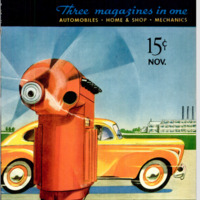 Popular Science Monthly. v. 137, n. 5 1940
Popular Science Monthly. v. 137, n. 5 1940

